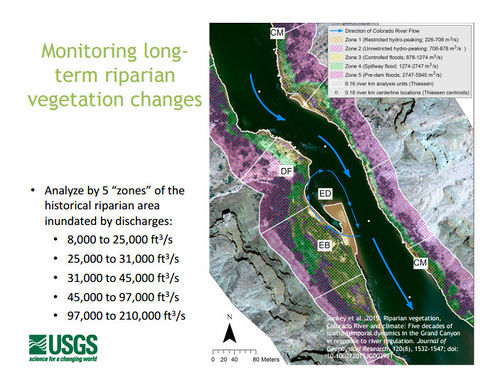Difference between revisions of "ECOSYSTEM"
Cellsworth (Talk | contribs) |
Cellsworth (Talk | contribs) |
||
| (One intermediate revision by the same user not shown) | |||
| Line 75: | Line 75: | ||
|style="color:#000;"| | |style="color:#000;"| | ||
| + | *[http://gcdamp.com/index.php?title=Portal:GCDAMP_Knowlege_Assessments GCMRC Annual Reports page] | ||
*[http://gcdamp.com/index.php?title=EXTIRPATED Species of Management Concern Page] | *[http://gcdamp.com/index.php?title=EXTIRPATED Species of Management Concern Page] | ||
*[http://gcdamp.com/index.php?title=Riparian_Vegetation Riparian Vegetation Page] | *[http://gcdamp.com/index.php?title=Riparian_Vegetation Riparian Vegetation Page] | ||
| Line 86: | Line 87: | ||
'''2016''' | '''2016''' | ||
| − | *[ | + | *[https://www.usbr.gov/uc/progact/amp/twg/2016-10-18-twg-meeting/Attach_04.pdf Linkages Between Lake Powell Reservoir and the Colorado River Below Glen Canyon Dam] |
| − | *[ | + | *[https://www.usbr.gov/uc/progact/amp/twg/2016-02-26-twg-meeting/AR10_Stevens.pdf The Biogeographic Significance of a Large, Deep Canyon: Grand Canyon, Southwestern USA] |
| − | *[ | + | *[https://www.usbr.gov/uc/progact/amp/twg/2016-02-26-twg-meeting/AR11_Anderson.pdf Ecosystem Monitoring in Glen Canyon National Recreation Area] |
'''2015''' | '''2015''' | ||
| − | *[ | + | *[https://www.usbr.gov/uc/progact/amp/amwg/2015-02-25-amwg-meeting/Attach_12.pdf The Stakeholder's Perspective - The National Parks Conservation Association] |
| − | *[ | + | *[https://www.usbr.gov/uc/progact/amp/amwg/2015-02-25-amwg-meeting/Attach_11.pdf Lower Colorado River Multi-Species Conservation Program Update] |
*[[Media:USGS State of the CR ecosystem in the Grand Canyon- c1282.PDF | USGS State of the Colorado River Ecosystem in the Grand Canyon- c1282]] | *[[Media:USGS State of the CR ecosystem in the Grand Canyon- c1282.PDF | USGS State of the Colorado River Ecosystem in the Grand Canyon- c1282]] | ||
'''2014''' | '''2014''' | ||
| − | *[ | + | *[https://www.usbr.gov/uc/progact/amp/twg/2014-10-28-twg-meeting/Attach_04.pdf Report on Ten Years of Implementing the Lower Colorado Multi-Species Conservation Program (MSCP)] |
'''2012''' | '''2012''' | ||
| Line 103: | Line 104: | ||
'''2010''' | '''2010''' | ||
| − | *[https://www.usbr.gov/uc/ | + | *[https://www.usbr.gov/uc/progact/amp/twg/2010-11-15-twg-meeting/Attach_11c.pdf Preliminary Update to TWG on Second Ecosystem Modeling Workshop] |
|- | |- | ||
Latest revision as of 16:06, 21 January 2022
|
|
LTEMP Resource Goal for Natural ProcessesRestore, to the extent practicable, ecological patterns and processes within their range of natural variability, including the natural abundance, diversity, and genetic and ecological integrity of the plant and animal species native to those ecosystems. Desired Future Condition for Native Species and Biotic CommunitiesNonfish Biotic Communities: CRE Riparian Domain: |
| --- |
--- |
--- |
|---|
|
|
